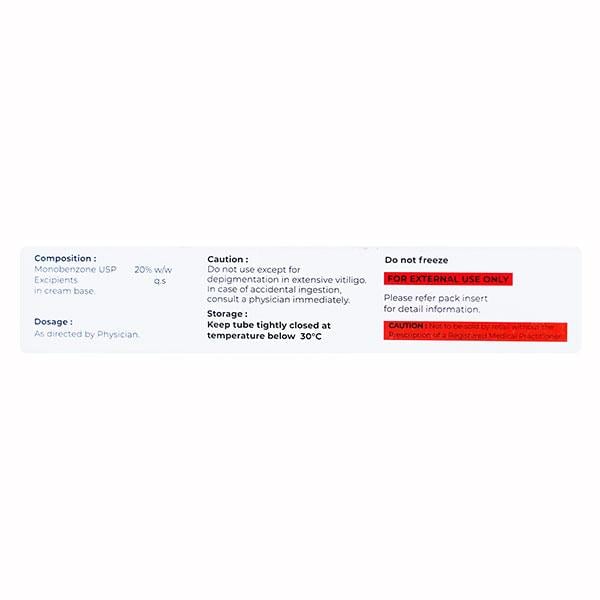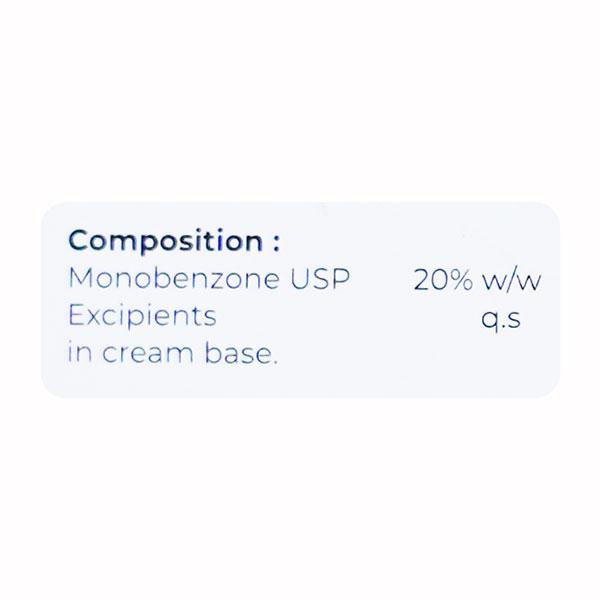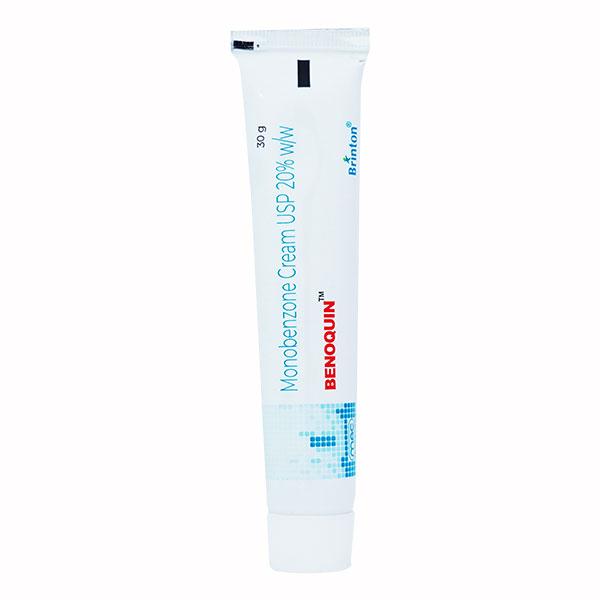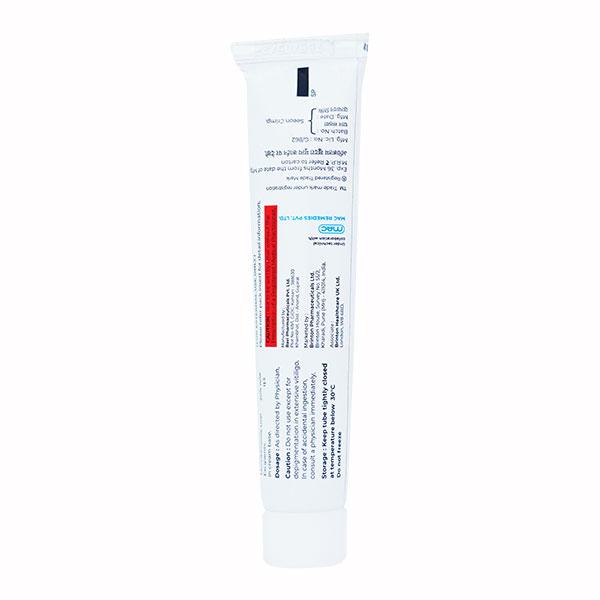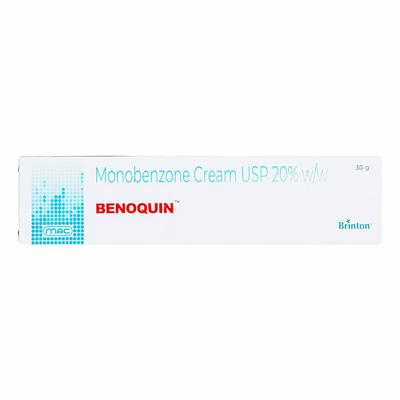

Netmeds First Membership
Quick Links
Introduction About BENOQUIN CREAM
BENOQUIN CREAM contains Monobenzone which belongs to the group of medicines called Depigmenting Agents. BENOQUIN CREAM is used to manage uneven appearance of skin (loss of skin colour) caused by vitiligo, which is a skin condition that occurs due to loss of brown colour (pigment) in skin resulting in white patches (on skin) in affected individuals.
BENOQUIN CREAM is not recommended for use in patients allergic to Monobenzone. It is also not recommended for use in patients suffering from hyper-pigmentation (darkened patches/spots on the skin due to other pigments), skin discoloration pigments (such as sunspots, age spots, freckles), and/or skin trauma.
BENOQUIN CREAM should be used with caution in pregnant and breastfeeding women only if it is clearly necessary. It is also advised to be used with caution in children and adolescents (aged 12 to 18 years) after consulting the doctor.
The most common side effects of applying BENOQUIN CREAM are skin irritation, and allergic contact dermatitis (skin rash). Consult your doctor if any of these side effects worsen.
Uses Of BENOQUIN CREAM
- Manage uneven skin appearance due to vitiligo
How BENOQUIN CREAM Works
BENOQUIN CREAM works by decreasing the amount of melanin (skin darkening pigment) from skin cells which results in uniformity of skin colour in affected individuals thus managing loss of skin colour due to vitiligo.
How to use BENOQUIN CREAM
Apply BENOQUIN CREAM as directed by your physician. It is for external use only. Check the label for directions before use. Avoid applying near to eyes/eyelids. Your doctor will decide the correct dose and duration for you depending upon your age, body weight and disease condition.
Side Effects Of BENOQUIN CREAM
Common
- skin irritation
- allergic contact dermatitis (skin rash)
Rare
- permanent depigmentation
- exogenous ochronosis (skin disorder characterized by blue-black pigmentation).
Stop applying BENOQUIN CREAM and consult with your doctor immediately if you experience any of the following side effects:
- signs of serious allergic reaction such as rash, itching, swelling of the face, tongue or throat, severe dizziness, and/or trouble while breathing
Warning & Precautions
Pregnancy
BENOQUIN CREAM should be used with caution during pregnancy only if it is clearly necessary. Consult your doctor before applying this medicine.
Breastfeeding
BENOQUIN CREAM should be used with caution in breastfeeding women as it is unknown whether the medicine may pass through breastmilk. Consult your doctor before applying the medicine.
Allergy
Do not apply BENOQUIN CREAM if you are allergic to Monobenzone, and/or any other ingredients of this medicine.
Others
BENOQUIN CREAM is not recommended for use if you:
- suffer from hyper-pigmentation (darkened patches/spots on the skin) due to other pigments
- suffer from skin discoloration pigments such as sunspots, age spots, freckles, skin discoloration (caused by hormone medicine), and/or skin trauma.
Use in Pediatrics:
BENOQUIN CREAM should be used with caution in children and adolescents (aged 12 to 18 years). It is advised to be used only if necessary in children (aged below 12 years) after consulting the doctor.
Interactions
A. Drug–Drug Interactions:
Inform your doctor if you are taking, have recently taken or might take any other medicines, including medicines obtained without a prescription.
Overdosage:
If you or anyone else applies too much of BENOQUIN CREAM or accidentally swallows it, consult your doctor immediately or visit the nearby hospital.
Synopsis
| Drug | : | Monobenzone |
| Pharmacological Category | : | Depigmenting Agent |
| Therapeutic Indication | : | Vitiligo |
| Dosage Forms | : | Cream |
More Information
- Keep BENOQUIN CREAM out of reach of children
- Store BENOQUIN CREAM at room temperature
FAQs About BENOQUIN CREAM
Q. What is BENOQUIN CREAM used for?
A. BENOQUIN CREAM is used to manage uneven appearance of skin (loss of skin colour) caused by vitiligo, which is a skin condition that occurs due to loss of brown colour (pigment) in skin resulting in white patches (on skin) in affected individuals.
Q. What are the common side effects of applying BENOQUIN CREAM?
A. The most common side effects of applying BENOQUIN CREAM are skin irritation, and allergic contact dermatitis (skin rash). Consult your doctor if any of these side effects worsen.
Q. How BENOQUIN CREAM is applied?
A. Apply BENOQUIN CREAM as directed by your physician. It is for external use only. Check the label for directions before use. Avoid applying near to eyes/eyelids. Your doctor will decide the correct dose and duration for you depending upon your age, body weight and disease condition.
Q. Can BENOQUIN CREAM be used in pregnant and breastfeeding women?
A. Yes, BENOQUIN CREAM can be used but with caution in pregnant and breastfeeding women only if it is clearly necessary. Consult your doctor before applying the medicine.
Q. How BENOQUIN CREAM works?
A. BENOQUIN CREAM works by decreasing the amount of melanin (skin darkening pigment) from skin cells which results in uniformity of skin colour in affected individuals thus managing loss of skin colour due to vitiligo.
References
1. Sean C Sweetman. Dermatological Drugs and Sunscreens. Martindale-The Complete Drug Reference. Thirty Sixth Edition. 2009. Page – 1607.
2. Achala Liyanage, Gayani Liyanage, Ganga Sirimanna, Nanna Schürer. Comparative Study on Depigmenting Agents in Skin of Color. NIH National Library of Medicine. National center for biotechnology information. PMC PubMed Central. February 2022. [Accessed on 4th August 2022] https://www.ncbi.nlm.nih.gov/pmc/articles/PMC8884189/
3. ICN Pharmaceuticals, Inc. Food and Drug Administration (FDA). [Accessed on 4th August 2022] https://www.accessdata.fda.gov/drugsatfda_docs/label/2003/08173slr015_benoquin_lbl.pdf
4. Puneet Laboratories Pvt Ltd. Albaquin. [Accessed on 4th August 2022] https://puneetlabs.com/albaquin/










